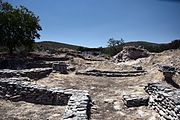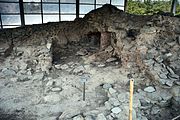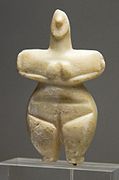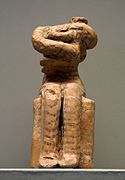
Çatalhöyük is a tell of a very large Neolithic and Chalcolithic proto-city settlement in southern Anatolia, which existed from approximately 7500 BC to 6400 BC and flourished around 7000 BC. In July 2012, it was inscribed as a UNESCO World Heritage Site.

The Neolithic or New Stone Age is an archaeological period, the final division of the Stone Age in Europe, Asia, Mesopotamia and Africa. It saw the Neolithic Revolution, a wide-ranging set of developments that appear to have arisen independently in several parts of the world. This "Neolithic package" included the introduction of farming, domestication of animals, and change from a hunter-gatherer lifestyle to one of settlement. The term 'Neolithic' was coined by Sir John Lubbock in 1865 as a refinement of the three-age system.
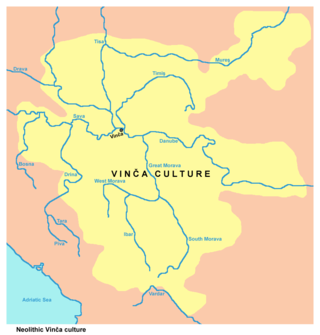
The Vinča culture, also known as Turdaș culture, Turdaș–Vinča culture or Vinča-Turdaș culture, is a Neolithic archaeological culture of Southeast Europe, dated to the period 5400–4500 BC. It is named for its type site, Vinča-Belo Brdo, a large tell settlement discovered by Serbian archaeologist Miloje Vasić in 1908. As with other cultures, it is mainly distinguished by its settlement pattern and ritual behaviour. It was particularly noted for its distinctive dark-burnished pottery.

The European Neolithic is the period from the arrival of Neolithic technology and the associated population of Early European Farmers in Europe, c. 7000 BC until c. 2000–1700 BC. The Neolithic overlaps the Mesolithic and Bronze Age periods in Europe as cultural changes moved from the southeast to northwest at about 1 km/year – this is called the Neolithic Expansion.
Old Europe is a term coined by the Lithuanian archaeologist Marija Gimbutas to describe what she perceived as a relatively homogeneous pre-Indo-European Neolithic and Copper Age culture or civilisation in Southeast Europe, centred in the Lower Danube Valley. Old Europe is also referred to in some literature as the Danube civilisation.

The Starčevo culture is an archaeological culture of Southeastern Europe, dating to the Neolithic period between c. 6200 and 4500 BCE. It originates in the spread of the Neolithic package of peoples and technological innovations including farming and ceramics from Anatolia to the area of Sesklo. The Starčevo culture marks its spread to the inland Balkan peninsula as the Cardial ware culture did along the Adriatic coastline. It forms part of the wider Starčevo–Körös–Criş culture which gave rise to the central European Linear Pottery culture c. 700 years after the initial spread of Neolithic farmers towards the northern Balkans.

Dimini is a village near the city of Volos, in Thessaly, in Magnesia. It was the seat of the municipality of Aisonia. The name Aisonia dates back to ancient times. Currently, Dimini is the westernmost place in the Volos area. The Dimini area contains both a Mycenean settlement and a Neolithic settlement. The Neolithic settlement in Dimini was discovered near the end of the 19th century and was first excavated by the archaeologists Christos Tsountas and Valerios Stais.

The Lengyel culture is an archaeological culture of the European Neolithic, centered on the Middle Danube in Central Europe. It flourished from 5000 to 4000 BC, ending with phase IV, e.g., in Bohemia represented by the 'Jordanow/Jordansmühler culture'. It is followed by the Funnelbeaker culture/TrB culture and the Baden culture. The eponymous type site is at Lengyel in Tolna county, Hungary.

Prehistoric Europe refers to Europe before the start of written records, beginning in the Lower Paleolithic. As history progresses, considerable regional unevenness in cultural development emerges and grows. The region of the eastern Mediterranean is, due to its geographic proximity, greatly influenced and inspired by the classical Middle Eastern civilizations, and adopts and develops the earliest systems of communal organization and writing. The Histories of Herodotus is the oldest known European text that seeks to systematically record traditions, public affairs and notable events.

In the archaeology of Southwest Asia, the Late Neolithic, also known as the Ceramic Neolithic or Pottery Neolithic, is the final part of the Neolithic period, following on from the Pre-Pottery Neolithic and preceding the Chalcolithic. It is sometimes further divided into Pottery Neolithic A (PNA) and Pottery Neolithic B (PNB) phases.

The Varna culture was a Chalcolithic culture of northeastern Bulgaria, dated c. 4500 BC, contemporary and closely related with the Gumelnița culture. The oldest golden artifacts in the world were found in the Necropolis of Varna. These artefacts are on display in the Varna Archaeological Museum.
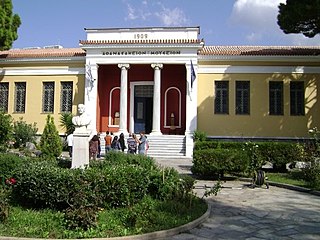
The Archaeological Museum of Volos, also known as Athanasakeion Archaeological Museum of Volos, is a museum located in Volos, Greece, that houses many exquisite finds from early 20th century and modern archaeological excavations in Thessaly. Exhibits on display include jewelry, household utensils and agricultural tools, originating from the Neolithic settlements of Dimini and Sesklo, as well as clay statuettes and a wide variety of items from the Geometric period, a time of great heroic events, such as the Argonaut Expedition and the Trojan War. There are also statues and uncommon jointed statuettes from the classical period, rare steles with relief work from the Hellenistic period wherein the colors are well-preserved, as well as reliefs from the early Christian and Byzantine periods. Other fascinating exhibits include tombs transported in their entirety from the archaeological sites where they were discovered, along with the human skeleton and the offerings placed around it. Just outside the museum there are some interesting reconstructions of the Neolithic houses at Dimini and Sesklo.
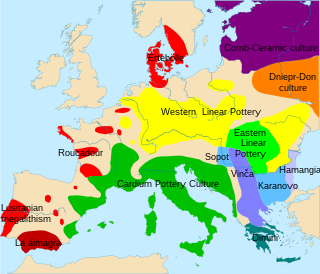
The Karanovo culture is a Neolithic culture named after the Bulgarian village of Karanovo. The culture, which is part of the Danube civilization, is considered the largest and most important of the Azmak River Valley agrarian settlements.

The prehistory of Southeast Europe, defined roughly as the territory of the wider Southeast Europe covers the period from the Upper Paleolithic, beginning with the presence of Homo sapiens in the area some 44,000 years ago, until the appearance of the first written records in Classical Antiquity, in Greece. First Greek language is Linear A and follows Linear B, which is a syllabic script that was used for writing in Mycenaean Greek, the earliest attested form of the Greek language. The script predates the Greek alphabet by several centuries. The oldest Mycenaean writing dates to about 1400 BC. It is descended from the older Linear A, an undeciphered earlier script used for writing the Minoan language, as is the later Cypriot syllabary, which also recorded Greek. Linear B, found mainly in the palace archives at Knossos, Kydonia, Pylos, Thebes and Mycenae, but disappeared with the fall of the Mycenean civilisation during the Late Bronze Age collapse.

Neolithic Greece is an archaeological term used to refer to the Neolithic phase of Greek history beginning with the spread of farming to Greece in 7000–6500 BC, and ending around 3200 BC. During this period, many developments occurred such as the establishment and expansion of a mixed farming and stock-rearing economy, architectural innovations, as well as elaborate art and tool manufacturing. Neolithic Greece is part of the Prehistory of Southeastern Europe.
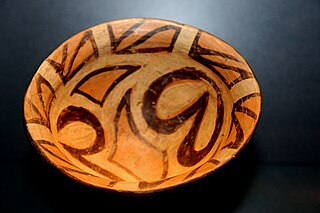
The study of the religion and ritual of the Cucuteni-Trypillia culture has provided important insights into the early history of Europe. The Cucuteni–Trypillia culture inhabited the present-day southeastern European nations of Moldova, Romania, and Ukraine during the Neolithic and Copper Ages. It left behind many settlement ruins that contain archaeological artifacts attesting to their cultural and technological characteristics.

The Gumelniţa culture was a Chalcolithic culture of the 5th millennium BC, named after the Gumelniţa site on the left (Romanian) bank of the Danube.
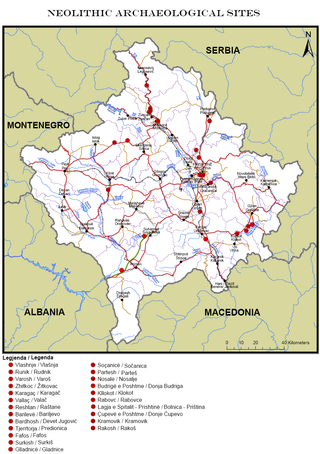
This is a description of Neolithic sites in Kosovo. The warm, humid climate of the Holocene which came soon after the ice melting of the last glacial period brought changes in nature which were reflected in humans, flora and fauna. This climatic stabilization influenced human life and activities; human society is characterized by changes in community organization and the establishment of permanent settlements in dry places, near riverbanks and on fertile plateaus.

Sesklo and Dimini are two of the main sites of the Greek Neolithic Period, ca. 6000-3000 BCE. They are located only a few miles apart in the Thessaly region of Greece and were excavated between 1899 and 1906 by Christos Tsountas. Both settlements included a large central megaron building surrounded by smaller buildings and houses, as well as enclosing walls. The purpose of these walls has long been debated, with Tsountas initially claiming that they had defensive military purposes. However, over time more and more archaeologists have concluded that they instead functioned as retaining walls, to mark habitation spaces, as animal enclosures, or were used for ritual purposes. Regardless of their intended purpose, the fortifications reinforced the distinction between the inner settlement and outside world.
The archaeology of Greece includes artificial remains, geographical landscapes, architectural remains, and biofacts. The history of Greece as a country and region is believed to have begun roughly 1–2 million years ago when Homo erectus first colonized Europe. From the first colonization, Greek history follows a sequential pattern of development alike to the rest of Europe. Neolithic, Bronze, Iron and Classical Greece are highlights of the Greek archaeological record, with an array of archaeological finds relevant to these periods.


